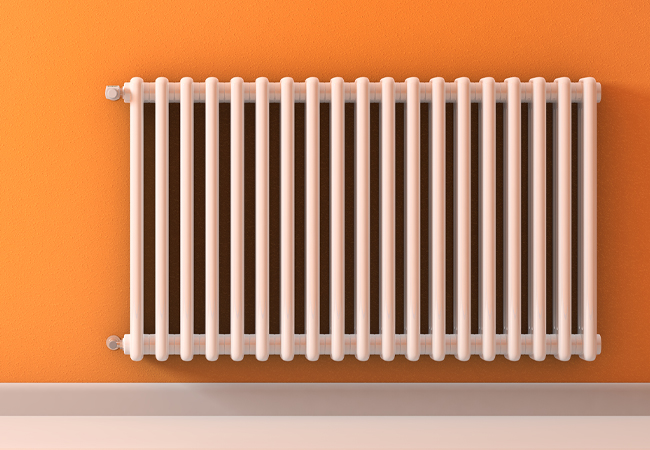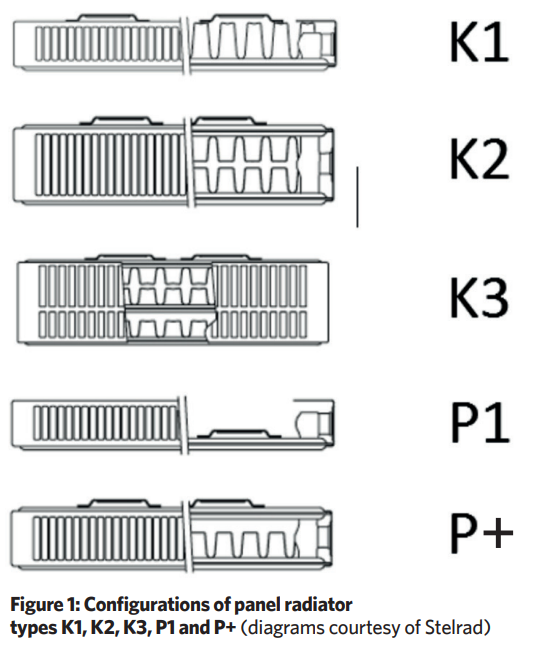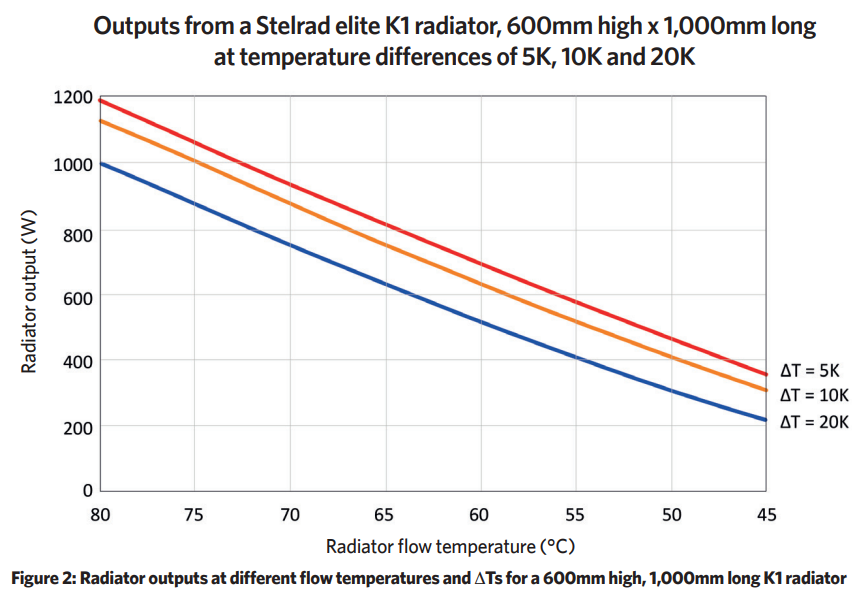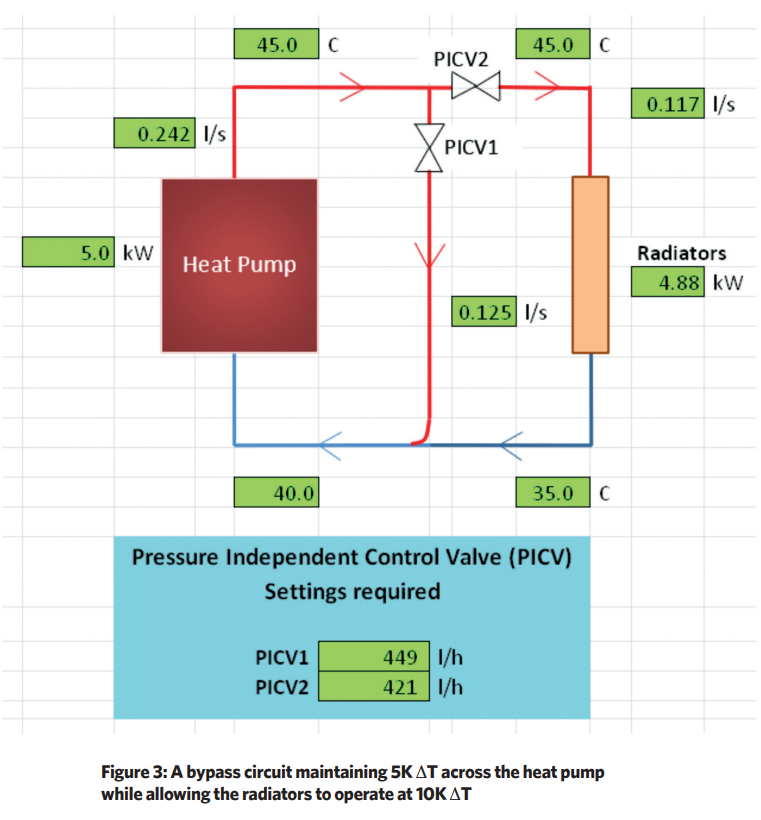
Within a few years, every heating designer and contractor in the UK will be installing heat pumps and upgrading heating systems. This will require the reskilling of engineers and contractors, not only in the design and installation of heat pump systems, but also in the upgrading of heat emitters and pipework to operate at low temperatures. This article addresses radiator and pipework upgrades for domestic heating installations, excluding hot water provision.
Operation at much lower flow temperatures will result in significantly lower radiator outputs, and heat pumps – which require a typical 5K maximum temperature drop – will require higher flow rates which may necessitate the replacement of heating pipework.
The output from a radiator is a function of the flow temperature (Tf), return temperature (Tr) and room ambient temperature (Ta) as defined in BS 442 as follows:

The output at 75°C flow, 65°C return and 20°C ambient (75/65/20) and the n-coefficient exponent are radiator dependent, and are supplied by the manufacturer in radiator output tables in accordance with BS 442. Radiators are described by the number of panels and fins, as shown in Figure 1. The industry standard panel radiator, from which all radiator outputs are calculated, is of type K1, 600mm high and 1,000mm long. At 75/65/20, the output is 1W per mm of radiator length to give a total of 1kW. The output at other temperatures can be calculated using the equation above, and is shown in Figure 2.
From the above, it is clear that operation at temperatures well below the typical 80°C/60°C or 82°C/71°C results in dramatically reduced radiator outputs, and that it is not possible to simply replace a boiler with a heat pump without taking measures to upgrade the building insulation, increase the size of the radiators, or both.
From a baseline of 5K ΔT across a radiator, increasing the radiator ΔT by 1K decreases the radiator output by between 1.0% and 1.3% for each 1K increase in ΔT above 5K. The output of this radiator at 5K ΔT at 45/40/20 is 36% of that at 80/60/20, while, at 10K ΔT, it is 31% of that at 80/60/20.
Radiator pipework
The majority of heat pumps require a very low condenser ΔT, typically 5K. If upgraded radiators are operated at a temperature difference of 5K, rather than the current 11K or 20K, the existing pipework may be too small and may have to be replaced.

Whether or not pipework needs to be upgraded along with radiators depends on the pipework material and internal pipe diameter. Take the example of a K1 radiator 600mm high x 1,000mm long, operating at 80/60/20 with an output of 1kW. If the radiator is upgraded to a K3 700mm high x 1,000mm long, at 45/40/20, it would produce almost the same output, 963W. If connected to 10mm 5-layer PEX barrier pipe (internal diameter 6.7mm) the pressure loss would be 3,822Pa.m-1 at 1.32m.s-1 velocity. If connected to 8mm copper minibore pipe (internal diameter 6.8mm), the pressure loss would be 3,646 Pa.m-1 at 1.28 m.s-1.
The significant increases in pressure drop, and potential increase in noise, may necessitate upgrading the pipework. By comparison, for the 700mm/1,000mm K3 radiator at 10K ΔT – ie, 45/35/20 – the output would be only 821W, giving 846Pa.m-1 and 0.56m.s-1 for 10mm PEX or 799Pa.m-1 and 0.55m.s-1 for 8mm copper. Operating at 7K ΔT – ie, 45/38/20 – the output would be 906W, giving 1,881Pa.m-1 and 0.89m.s-1 for 10mm PEX, and 1,786Pa.m-1 and 0.86m.s-1 for 8mm copper. In both of these situations, it is very likely that the existing pipework could be reused.
A hybrid solution could avoid the need to upgrade pipework as radiator sizes are increased, as described above. While it is essential not to exceed the maximum permitted condenser ΔT for the heat pump, the radiators are not necessarily constrained to operate at the same ΔT. Figure 3 shows the configuration required to maintain a constant and controlled ΔT across the heat pump while permitting a greater ΔT across the radiators.
Two pressure independent control valves are used to set and maintain the flowrates along the bypass and into the radiator circuit. This guarantees that the heat pump manufacturer’s preferred ΔT will not be exceeded, while allowing the radiators to operate at 10K ΔT. This may avoid the need to replace the interconnecting pipework.
Building heat loads and very cold weather operation
Radiators are usually sized for the load – including a heat-up allowance – at the design external air temperature, a location-dependent figure, but typically around -3°C for much of the UK.

Two issues must be considered when converting to heat pump operation. First, heat pumps should not be oversized, which means, unlike a boiler, they will not have spare capacity to operate in very cold weather below the design outside air temperature. While boiler temperatures can usually be increased to cope with very cold weather with little efficiency penalty, increasing the flow temperature from a heat pump can result in a significant reduction in performance. Furthermore, air source heat pumps may not work well below 2°C dry bulb outside air temperature because of the need to defrost evaporator coils regularly. This is a very important consideration when choosing the type of heat pump to install.
The solution to cold weather operation would appear to be a hybrid system – for example, retaining a boiler for use below 2°C and interlocking it so it cannot operate at the same time as the heat pump. Some gas condensing boilers have a calibrated temperature-setting control, which allows the user to adjust the flow temperature to a specific value.

Typically, flow temperatures from 45°C to 82°C can be set on the dial, which allows the performance of an existing heating system at low temperatures to be evaluated before heat pump installation. This could give useful data when determining the extent of radiator upgrades required.
Comfort
The currently accepted measure of comfort is expressed by the operative temperature (To). CIBSE Guide B1 defines To as the average of the air temperature and the mean radiant temperature as in equation 2: T0 = 0.5Tr + 0.5Ta
Heat pumps will not have spare capacity to operate in very cold weather below the design outside air temperature
The mean radiant temperature is calculated by multiplying the area of each surface in a room by its temperature, summing these products together, then dividing the result by the total surface area.
Clearly, the use of radiator surface temperatures of less than 45°C compared with the current 65°C or more will produce a lower overall mean radiant temperature, and achieving the same comfort level will generally require a higher air temperature and, hence, radiator outputs.
Procedure for radiator and pipework design
Following a room-by-room heat-load calculation, radiators should initially be sized based on the flow and return temperatures for the selected heat pump. Radiators of the same length as the existing ones, but of a higher output type and/or greater height, should be chosen, with the aim of using the existing pipework.
A check of the pressure drop and velocity in each pipe will show whether radiators can be operated at the heat pump ΔT or whether the radiator ΔT needs to be greater than the heat pump ΔT, noting that it is only when the smallest pipe sizes are present that it may be necessary to replace pipework.
All of the calculations required can be done using the radiator and pipework calculator, downloadable at bit.ly/CJApr22RPSC
About the author
David Palmer, is now retired. He was formerly a director of the Campbell Palmer Partnership
Acknowledgements
- Chris Harvey, Stelrad head of marketing UK & Ireland, for support, use of Stelrad data, and validation of radiator calculations
- Ryan Kirkwood, heat pump business development manager Baxi Heating, for important contributions to the article
